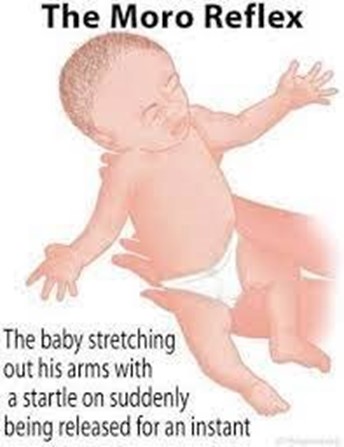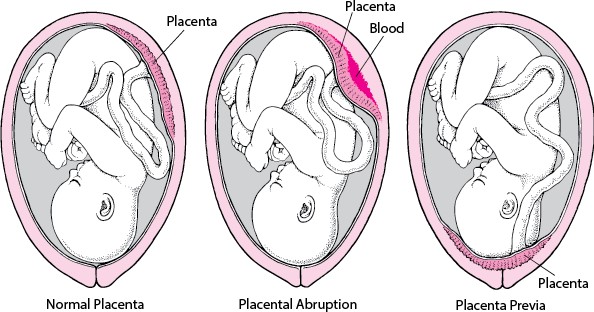The nurse is performing a newborn physical assessment and is about to elicit the Moro reflex. Which of the following responses should the nurse expect to see?
Select one:
The cheek of the newborn is touched, and the newborn turns toward the side that was touched.
The newborn is suddenly lowered or startled, and they extend their arms, legs and neck, then rapidly bring their arms together.
The newborn is supine and their head is turned to one side, then the arm on that same side extends.
The lateral aspect of the sole of the newborn's foot is stroked, and the toes extend and fan outward.
The Correct Answer is B
Choice A Reason: The cheek of the newborn is touched, and the newborn turns toward the side that was touched. This is an incorrect answer that describes a different reflex called the rooting reflex. The rooting reflex is a feeding reflex that helps the newborn locate the nipple and initiate sucking. The rooting reflex is elicited by stroking the cheek or corner of the mouth of the newborn, which causes them to turn their head and open their mouth toward the stimulus.
Choice B Reason: The newborn is suddenly lowered or startled, and they extend their arms, legs and neck, then rapidly bring their arms together. This is because this response describes the Moro reflex, which is a primitive reflex that is present at birth and disappears by 3 to 6 months of age. The Moro reflex is elicited by simulating a falling sensation or a loud noise, which triggers a fear response in the newborn. The Moro reflex consists of four phases: extension, abduction, adduction, and crying.
Choice C Reason: The newborn is supine and their head is turned to one side, then the arm on that same side extends. This is an incorrect answer that refers to another reflex called the tonic neck reflex. The tonic neck reflex is a postural reflex that helps prepare the newborn for voluntary reaching. The tonic neck reflex is elicited by placing the newborn in a supine position and turning their head to one side, which causes them to assume a "fencing" posture with one arm extended and one arm flexed.
Choice D Reason: The lateral aspect of the sole of the newborn's foot is stroked, and the toes extend and fan outward. This is an incorrect answer that indicates a different reflex called the Babinski reflex. The Babinski reflex is a neurological reflex that tests for spinal cord integrity. The Babinski reflex is elicited by stroking the lateral aspect of the sole of the foot from heel to toe, which causes the big toe to dorsiflex and the other toes to fan out.

Nursing Test Bank
Naxlex Comprehensive Predictor Exams
Related Questions
Correct Answer is B
Explanation
Choice A Reason: Shoulder dystocia. This is an incorrect answer that describes a different obstetric complication. Shoulder dystocia is a condition where the baby's shoulder gets stuck behind the mother's pubic bone during delivery, which can cause nerve injury, fracture, or asphyxia to the baby. Shoulder dystocia does not cause fetal bradycardia, abdominal pain, or vaginal bleeding.
Choice B Reason: Placental abruption. This is a correct answer that explains the symptoms of fetal bradycardia, abdominal pain, and vaginal bleeding in a woman with a history of crack cocaine use. Placental abruption. This is because placental abruption is a condition where the placenta separates from the uterine wall before delivery, which can cause fetal distress, maternal hemorrhage, and shock. Placental abruption can be triggered by maternal hypertension, trauma, or substance abuse, such as crack cocaine.
Choice C Reason: Anaphylactoid syndrome of pregnancy. This is an incorrect answer that refers to a rare and fatal condition also known as amniotic fluid embolism. Anaphylactoid syndrome of pregnancy is a condition where amniotic fluid enters into the maternal bloodstream and causes an allergic reaction, which can lead to respiratory failure, cardiac arrest, coagulopathy, and coma. Anaphylactoid syndrome of pregnancy does not cause fetal bradycardia or vaginal bleeding.
Choice D Reason: Placenta previa. This is an incorrect answer that indicates another placental disorder. Placenta previa is a condition where the placenta covers or is near the cervix, which can cause painless bright red bleeding during pregnancy or labor. Placenta previa does not cause fetal bradycardia or abdominal pain.

Correct Answer is B
Explanation
Choice A Reason: Prepare for IV dextrose administration. This is an incorrect answer that indicates an unnecessary and invasive intervention for an IDM with normal blood glucose. IV dextrose administration is indicated for an IDM with severe or persistent hypoglycemia, which is defined as a blood glucose below 40 mg/dL or below 60 mg/dL after two feedings.
Choice B Reason: Provide routine care, per hospital IDM protocol. This is because a blood glucose of 60 is within the normal range for an IDM, which is 40 to 80 mg/dL. An IDM is a newborn whose mother has pre-existing or gestational diabetes, which can affect the fetal and neonatal glucose metabolism and regulation. An IDM may have hypoglycemia (low blood glucose), hyperglycemia (high blood glucose), or other complications such as macrosomia, polycythemia, or congenital anomalies. An IDM requires routine care and monitoring according to the hospital IDM protocol, which may include blood glucose testing, feeding, temperature regulation, and observation for signs of distress.
Choice C Reason: Place the infant in a warmed incubator. This is an incorrect answer that suggests an irrelevant and potentially harmful action for an IDM with normal blood glucose. Placing the infant in a warmed incubator is indicated for an IDM with hypothermia, which is a low body temperature that can impair glucose utilization and increase oxygen consumption. However, placing the infant in a warmed incubator without proper indication can cause hyperthermia, which is a high body temperature that can lead to dehydration, electrolyte imbalance, or brain damage.
Choice D Reason: Alert the clinician immediately for orders. This is an incorrect answer that implies an urgent and unwarranted situation for an IDM with normal blood glucose. Alerting the clinician immediately for orders is indicated for an IDM with signs of distress or complications, such as apnea, cyanosis, seizures, or jaundice.
Whether you are a student looking to ace your exams or a practicing nurse seeking to enhance your expertise , our nursing education contents will empower you with the confidence and competence to make a difference in the lives of patients and become a respected leader in the healthcare field.
Visit Naxlex, invest in your future and unlock endless possibilities with our unparalleled nursing education contents today
Report Wrong Answer on the Current Question
Do you disagree with the answer? If yes, what is your expected answer? Explain.
Kindly be descriptive with the issue you are facing.
